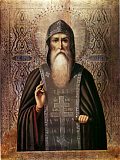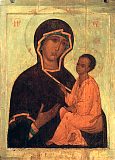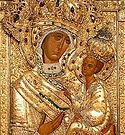

| Previous day | Next day |
| Old Style
June 26
|
Saturday |
New Style
July 9
|
|
4th Week after Pentecost.
Tone 2.
Fast of the Holy Apostles. |
Fish, wine and oil allowed.
|
![]() Appearance of the Tikhvin Icon of the Most Holy Theotokos (1383).
Appearance of the Tikhvin Icon of the Most Holy Theotokos (1383). ![]() St. David of Thessalonica (540).
St. David of Thessalonica (540).
St. John, bishop of Gothia in the Crimea (ca. 800). St. Dionysius, archbishop of Suzdal (1385). Uncovering of the relics of St. Tikhon of Lukhov (1569). Translation of the relics of St. Nilus of Stolobny (1995).
Icon of the Most Holy Theotokos “Of Lydda” (1st c.) Icon of the Mother of God “Neamts” (1399). and “Of the Seven Lakes” (Kazan) (17th c.).
St. Brannock (Brynach) of Braunton, England (6th c.). Martyr Pelagius of Cordoba (925). New Martyr David of St. Anne’s Skete, Mt. Athos, at Thessalonica (1813).
Thoughts for Each Day of the Year
According to the Daily Church Readings from the Word of God
By St. Theophan the Recluse

Saturday. [Rom. 6:11-17; Matt. 8:14-23]
To one of those who wanted to follow the Lord, He said: The Son of man hath not where to lay his head, and to another who wanted first to bury his father, He said to leave the dead; others will bury him, but you follow Me. This means that he who wants to follow the Lord should not expect any comfort on the earth after following Him, but only deprivations, needs and sorrows; and it means that worldly cares, even the most legitimate, are not compatible with following Him. It is necessary to decisively renounce everything, so that nothing attaches you to the earth, and then to condemn yourself to many sufferings or your cross. Having thus prepared yourself, follow the Lord. This is the direct will of the Lord! But who is this commandment for—only the Apostles, or for all Christians? Let each figure it out himself. Deny yourself and take up the cross. Was this said to everyone? Love the Lord more than father and mother, brothers and sisters, wife and children—is this said to everyone? The conclusion is clear. What should we do? One time the Apostles posed the same question to the Lord, and He answered them, The things which are impossible with men are possible with God (Luke 18:27).
Articles
 Appearance of the Tikhvin Icon of the Mother of God |
 St David of Thessaloniki |
 St Dionysius the Archbishop of Suzdal |
 Venerable Tikhon of Luchov, KostromaSt Tikhon of Lukh, and Kostroma (in the world Timothy), was born within the bounds of the Lithuanian princedom and was in military service there. |
 Icon of the Mother of God of Seven LakesThe “Seven Lakes” Icon of the Most Holy Theotokos shone forth with many miracles in the seventeenth century in the area of Kazan. |






